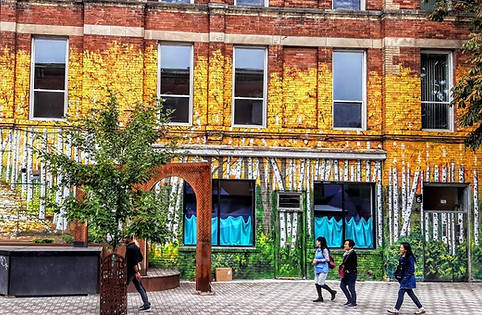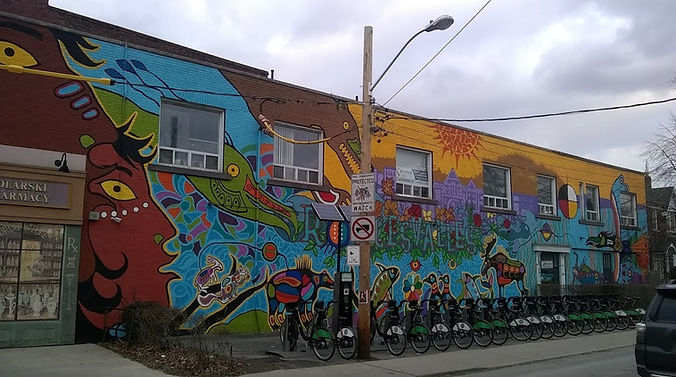
Street art as an accessible outdoor gallery
An interview with Jim Bravo
Photo credit: Jim Bravo
See this art on the city's map here.
Jim Bravo's favourite mural that he's worked on, called "Isn't it good to get lost in the woods," shown above, shows an autumnal scene of Birch trees as their leaves change colour. The mural is bright with white, orange, yellow and green throughout, blending seamlessly into the brick background that it is painted on. View more of Jim's work on his website.
Asha Swann 00:01
On this episode of Toronto's Artery, I spoke with Jim Bravo, an artist who has won multiple awards for his murals throughout the city. Jim and I spoke about how art can actually make people feel safer within their own neighbourhoods.
Asha Swann 00:19
You've done quite a lot of murals for the city's different BIAs, how did you get started doing murals and outdoor art?
Jim Bravo 00:28
I'd say I mean, in terms of the whole mural industry that is alive and thriving now, the first one that I did in that way was was 2007. I was approached by a community group called—at that time, they were called Arts for Children and Youth, but now they're called VIBE. They're a good resource for mural projects and people with experience so they're called VIBE now, at 401 Richmond. Anyway, so they had me do a project for—that was being sponsored by Tropicana, it was sort of a summer youth employment thing, where I was leading a group of youth and we put a mural up on the side of a building. I have a team of like, maybe five or six, and they were hired by them. And then they hired me, and we worked for the entire summer on that; that was the first one that I did. And then it just sort of kept going, like I kept being either recommended for something or applying for another mural call. The city established the, funnily enough, we have Rob Ford—which is strange—like, I kind of owe my career to Rob Ford.
I'm not even, I'm not a fan of the Fords at all. But he established this anti-graffiti program where he told businesses to clean up their walls, he said, "Look, we'll give you money to put the mural up there. So why don't you guys apply?" The city sort of started doing that, and establishing that as a way. So it's been since 2007, that I've been sort of like doing all these community art projects, or I've been applying for requests for proposals. So if a company sends out a notice, then I'll send an application in with a proposal. And you know, if I get chosen, then I am the one that does that mural, right? And in terms of the BIAs, and that's something that I got into, as well as the results of several calls and references. It's strange. It's like, even when I started in 2007, it was still a pretty small industry. Now, of course, it's just massive, because now you have the street art component of the city of Toronto, and they are behind several the big monumental works you see. I've done some work with them, too—work with and for them, as well. So now it's something that people can actually have as a viable source of income as opposed to just like—it's mostly seasonal, because a lot of the work is outdoors. But it's become this thriving industry. I actually never thought I'd get paid for anything like that. But it's pretty viable.
Asha Swann 02:50
What sort of impact have you noticed on the community, since there's been this movement to replace vandalism with murals?
Jim Bravo 02:59
People take more notice than you would think. They come up to you. And they say, you know, "Thank you. This wall has been an eyesore for so many years," or, "It's been a place where, you know, dodgy or sketchy people gather and now that the mural is up, that beautification sort of lends a whole new sort of like positivity to that area." It makes people feel safer in a strange way, right? Because it gives it some respectability. So that's one positive thing. People are always saying, "Thank you so much, it brightens my day, it brightens the neighbourhood and makes us feel safe." That kind of thing. The murals have a really profound—I mean, they're basically outdoor galleries, right? You know, when you're parading through a museum or a gallery, there's this sort of like referential kind of feeling when you're looking at a painting. We've just brought that outside. And people stand in front of the mural, and they have this connection to it, and they have this sort of quiet moment. It just has a really positive effect on people for some reason, you know?

Roncesvalles, BIA
Photo source: Jim Bravo
This mural was a collaboration between Jim Bravo and Philip Cote, winning that year for the TABIA (Toronto Association of Business Improvement Areas) awards ceremony. The mural is colourful and stretches from the top to the bottom of a building.
Asha Swann 03:56
I have only lived here for a couple of years for school, but I know that for me, I'm from Ottawa originally and there isn't a ton of murals that— at least that I had noticed in Ottawa. So here I find it's really incredible that you can walk down so many alleyways, especially Kensington Market, but so many neighbourhoods, for sure, you can see tons of art I find it's like a really positive experience, at least for someone like me, looking on the outside in.
Jim Bravo 04:19
It's introduced a whole new character and flavour to the city. It puts a jump in their strut, you know?
Asha Swann 04:26
Did you find that during the COVID lockdown, do you find that it was harder to get outdoors and create art? Or did you notice that you were more drawn towards paintings and doing things indoors? Or I guess what was your experience like with that?
Jim Bravo 04:39
I did a couple of indoor projects during COVID on private murals for a couple of centers. My own work, I did a lot of my own painting. Of course, we were all at home and you know, having to deal with isolation and all that. So there was a spike in my own production, like my personal work, which is good. In terms of murals, I did a couple outside murals during COVID, it didn't really affect it. Because mainly, you know, you can do a mural on your own. So it was easy to get one done, or get one or two done during COVID because it was a very solitary experience anyway.
Asha Swann 05:13
Do you have any murals that you've done that have really stood out to you as like some of your favourite projects to work on?
Jim Bravo 05:19
Yeah, there's the one. It's called, "Isn't it Good to Be Lost in the Woods." That one is at Denison and Queen, which is near Spadina and Queen. And that one was commissioned by the Queen West BIA, and it's, it's a forest trail that leads back from a community stage, it's the backdrop of a community stage. And everyone loves that—I love that one. It has a very, very cool feel. It's become a gathering place. I believe that one—yeah, that one also won an award. I've had three of those mural awards, they called the Toronto Association of Business Improvement Areas—TABIA. They give out mural awards every year, and I have the one for 2018, 2019, and 2021. So they're being recognized. That's a good one. I like that one. I like doing landscapes. So I had the chance with that one to just do a big expressive landscape. I think it captured—successfully captured the feeling and mood. Because that's such a busy area, I had all sorts of tourists coming up to me and asking, "Wow, that's what you do?" And taking pictures, of course, for Instagram and all that.
Asha Swann 06:28
How did it feel winning this award for three different years?
Jim Bravo 06:33
The first time it happened, I was pretty excited. And of course, the second time I was surprised. I'm like, "Whoa, again?" And then the third time, which was just last month, I was like — I thought there was a mistake or something because I went to the first two ceremonies — which are held at Palais Royale. And then somebody forgot to tell me [laughs] that I won for this year, too! They're like, "Hey, Jim, you weren't at your award unveiling." I'm like "What award unveiling?" So that was really funny, because I mean, somebody just forgot to tell me that I won. So I found out like a couple of days later, but it was just a comedy of errors. But that one was also a surprise, too. But nonetheless, it's still a good thing to have in the resume or whatever, on record.
Asha Swann 07:14
That's pretty funny that they had that sort of mix-up.
Jim Bravo 07:17
It's so weird, like, because usually I'll get a notice from the city because it's a city award, right? And somebody figured that somebody was going to tell me, but nobody did it.
Asha Swann 07:26
Yeah. Oh, my gosh, a little, definitely a little mix up there [Laughs]. Do you have any upcoming outdoor projects in the spring or summer that you think people should check out?
Jim Bravo 07:36
There's nothing definite apart from a private mural that I'm doing for a business on Roncesvalles. And that's going to be on the upper-level wall, that you'll be able to see—like when you're walking down Roncesvalles, when you're walking south, you'll be able to see it from quite a distance. So it's gonna be that's pretty cool. I'm excited for that. That will start, I suppose in April, once the weather gets decent. And there's a few new projects that I put my name in—my hat in the ring for, so if those come through, then I'll get back to you. But as of right now, I've only got the one. This is—right about now is where you begin to be approached by people and when the application process speeds up and the contract and sort of like, opportunities come, come up. So there'll hopefully be something where I'm active and people can actually come by, you know, like the last one we did for Yonge, Uptown Yonge BIA, that was pretty cool. That was a very active scene. And because there was a courtyard in front of it, so there were benches and people would come and just sort of stare, you know? It's strange being like — having to produce art in that way. It's so different from producing art in my own studio at home because nobody's watching. It's just me. But you go from that to the exact opposite, where everybody's watching. It's performative in a way. Murals are a performative art, which is pretty strange.
Asha Swann 09:00
This has been an episode of Toronto's Artery, a podcast about art in the heart of the city. For more episodes, and to see a map of the art we discussed in today's episode, head to torontosartery.com.
Thanks for listening!
